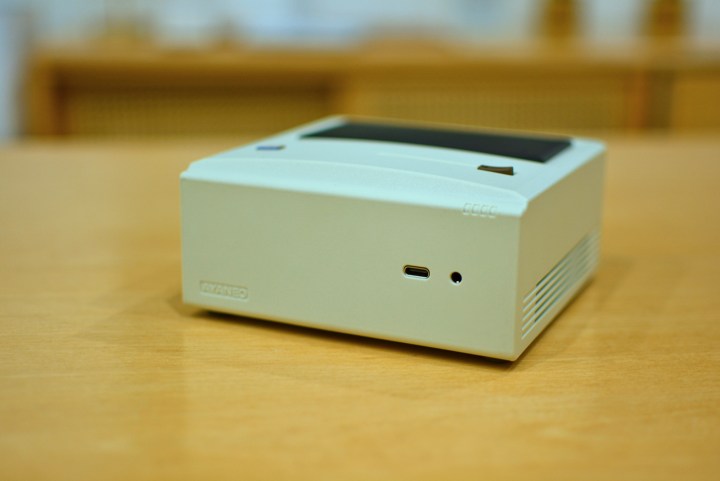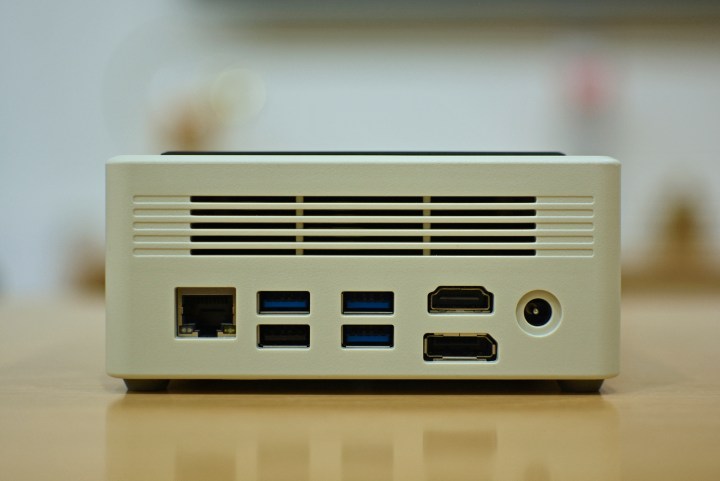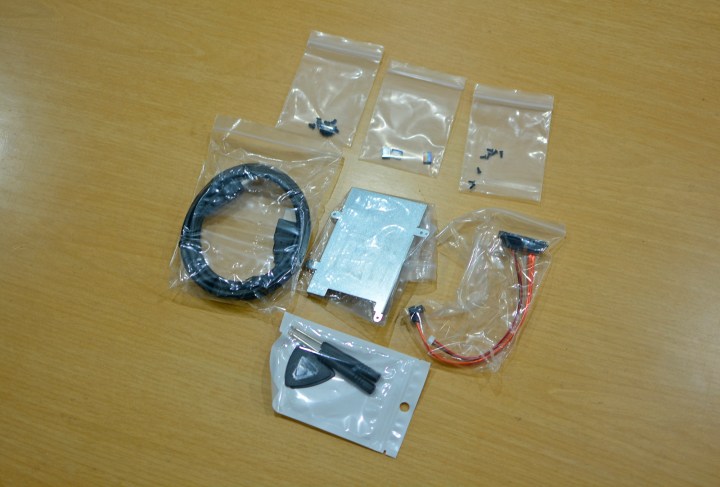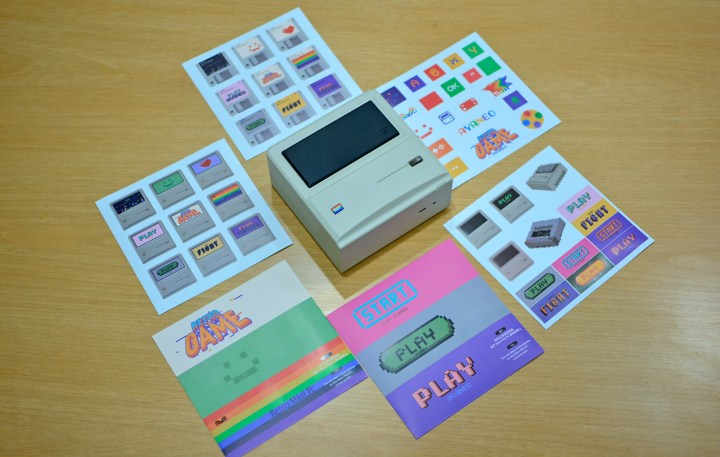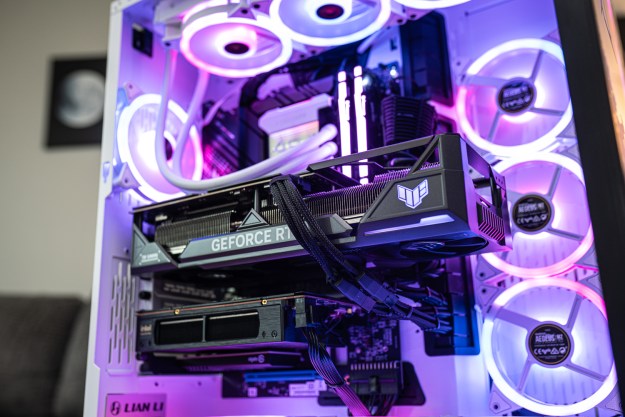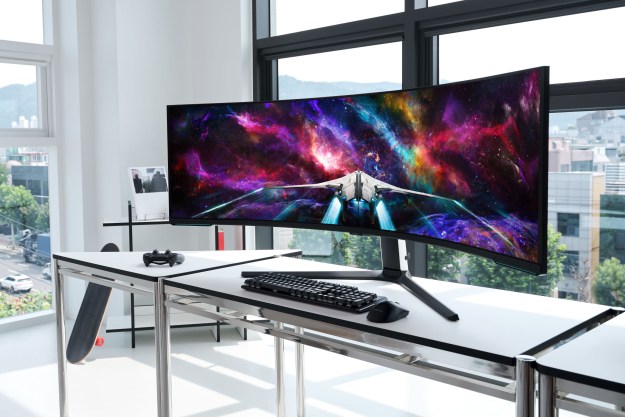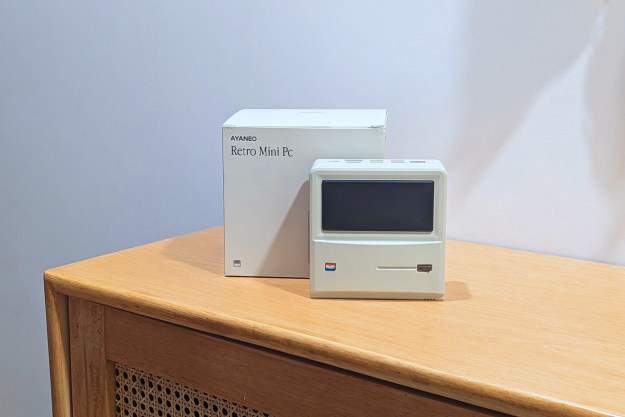
- All the retro vibes
- Attractive, compact design
- Plenty of ports
- Ease of service and upgradability
- Solid value
- 8GB model is very limited
- AyaSpace software needs tweaking
Nostalgia is one hell of a drug.
Ayaneo is on a journey to make us all relive the simpler, earlier days of tech as part of its ‘Remake’ series. Their handheld gaming systems have the most buzz, but the one I was most interested in was the Retro Mini PC AM01, with obvious ties to the original Macintosh. It’s aimed at light gaming and everyday computing, all with a retro vibe that flair up the generic world of mini PC design. It’s more than just a gimmick, though the main appeal is the retro joy this little PC brings.
Specs and pricing
| CPU | AMD Ryzen 7 5700U AMD Ryzen 3 3200U |
| GPU | AMD Radeon 8 iGPU |
| Memory | Up to 64GB DDR4-3200 (Ryzen 7 5700U) Up to 32GB DDR4-3200 (Ryzen 3 3200U) |
| Storage |
256GB / 512GB / 2TB PCIe Gen 3 SSD |
| Power rating | 35W |
| USB ports | 1xUSB 3.2 Gen1 Type-C (data only)
3xUSB-A 3.2 Gen2 1xUSB-A 2.0 |
| Video out | HDMI 2.0
DisplayPort 1.4 |
| Connectivity | 1 gigabit Ethernet
Wi-Fi 6, Bluetooth 5.2 (Ryzen 7 5700U) WiFi 5, Bluetooth 4.2 |
Right now, you can only purchase the Ayaneo Retro Mini PC AM01 from Indiegogo, with limited units up for grabs. Depending on your needs and preferences, there are various configurations to choose from, with two CPU options: AMD Ryzen 7 5700U and Ryzen 3 3200U.
You can get it in a barebones configuration, too, if you have your own RAM and storage. Pricing starts at $200 for the Ryzen 3 3200U bundled with 8GB RAM and a 256GB SSD. The most high-end option featuring the Ryzen 7 5700U, 32GB
Design
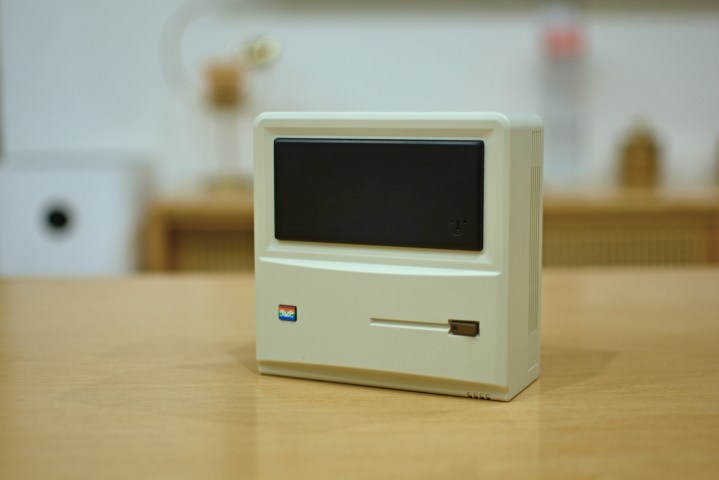
Ayaneo deserves full credit for dedicating itself to the design and incorporating intricate details into this mini-PC. The distinctive creamy textured plastic shell, the power button designed like a switch, and the classic air vents all contribute to the appeal. It bears enough resemblance to the original Macintosh that makes it instantly recognizable. It’s the smallest details of the design that sell the aesthetic, and I totally bought it.
It truly stands out, despite taking a tiny bit of space on your desk, measuring 5.1 inches in length and width with a height of 2.38 inches. For comparison’s sake, the Retro Mini PC AM01 has a smaller footprint than the Mac mini but is a bit taller and chunkier. The point is that it should easily fit under your monitor or even around your TV if you intend to use it as a multimedia PC.
Not that you’d want to hide it, of course. Showing off that you’re running an entire PC experience out of this adorable little chassis is half the fun.
Ports and internals
There’s proper ventilation on the sides and the bottom, along with a nice selection of ports. At the back are three full-size USB Type-A ports with 3.2 Gen 2 speeds, a single USB 2.0 port, HDMI 2.0, Display Port 1.4, an Ethernet jack, and a barrel charging port. At the front, there’s also a USB Type-C 3.2 Gen 1 port and a 3.5mm audio combo jack.
I was also impressed with Ayaneo’s approach towards packaging. Apart from the usual set of documentation, the mini PC comes with a healthy bunch of add-ons and accessories that make the entire experience worth the asking cost.
Not only do you get stickers and magnets, but the mini PC comes with an HDMI 2.0 cable, swappable regional plugs for the wall charger, a spare set of screws, and even two tiny screwdrivers with plastic spudgers.
There’s flexibility in terms of service and upgradability, too. The bottom cover can be taken off by removing four screws in each corner that also hold the rubber feet in place. It’s a pretty simple process, and the bundled screwdrivers and spudgers come in handy. The cooling solution covers most of the mainboard; hence, the RAM and storage are on the other side.
To get access, you need to remove three small screws that hold the mainboard into place, followed by a few delicate cables. It is also important to read the manual before you start poking around.
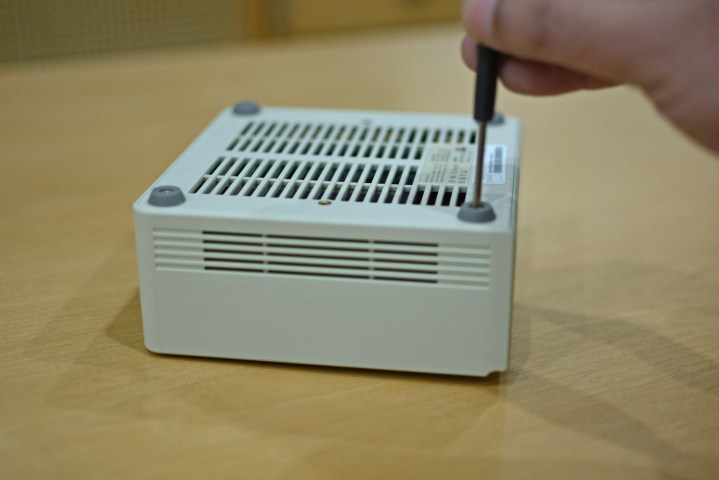
There are two memory slots (SODIMM-type) that support DDR4 RAM, which is notably selling pretty cheaply at the moment. In terms of storage, there’s a PCIe M.2 2280 slot and the option of installing a 2.5-inch SSD with all the necessary cables and mounting plate included in the package. Like most laptops, the Wi-Fi module can also be replaced or upgraded on the AM01.
Now, that’s something you can’t do on a Mac mini, that’s for sure.
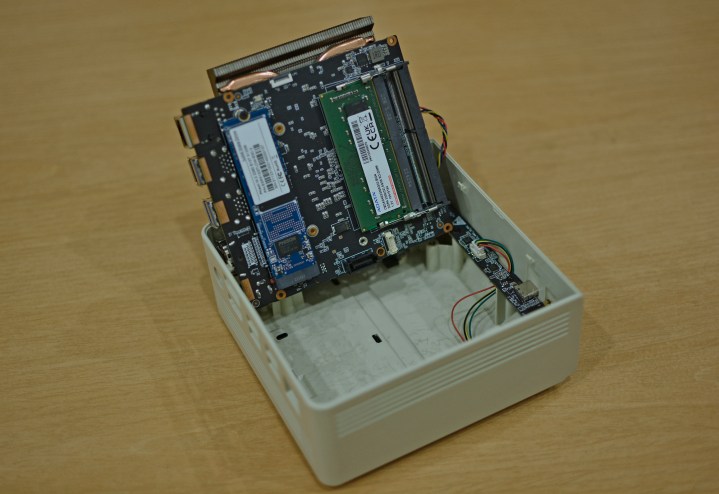
The review unit sent to me included a single stick of 8GB DDR4 3200MHz memory and a 512GB PCIe Gen 3 SSD made by Phison. Now Gen 3 SSD speeds aren’t terrible, but the included drive could’ve been better. It offered sequential read and write speeds of up to 2,400MBps and 1,250MBps in CrystalDiskMark, leaving some headroom for a faster drive.
Performance
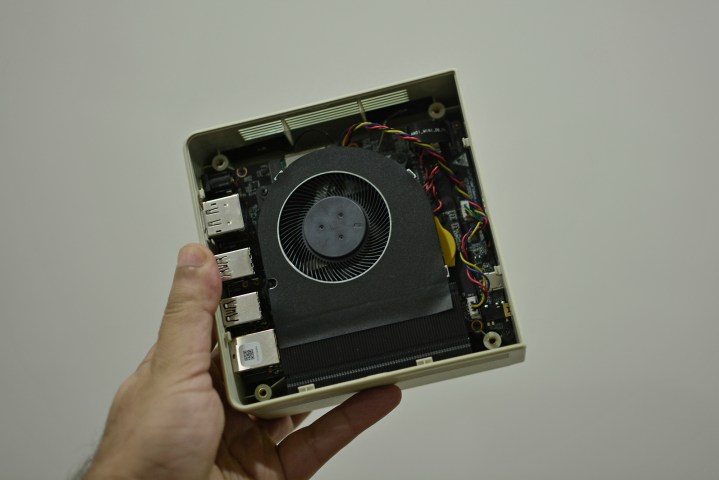
The company clearly says that this machine is not meant for modern games, rather the hardware is suitable for office work, casual multimedia and internet browsing as well as retro console game emulation. The unit I got included the more powerful Ryzen 7 5700U, which features an 8-core CPU that can turbo up to 4.3GHz and integrated Radeon graphics with 8-cores and 1900MHz clock speeds.
Sure, it isn’t the fastest compared to today’s standards, but the chip is fairly reliable. Ayaneo has tweaked the power rating so it can push up to 35W, which, in my opinion, should be plenty for what this machine is intended for.
To get a sense of the performance the AM01 offers, I updated the drivers along with all the latest Windows 11 updates before running some basic benchmark tests. Within a few hours, I realized that 8GB of RAM was just not cutting it. The system was visibly slowing down when opening more than two or three applications and running them side by side. The good thing is that I could bump the memory up to 16GB by adding another 8GB stick for only $20.
|
Ayaneo AM01 (Ryzen 7 5700U + 16GB RAM) |
Ayaneo AM01 (Ryzen 7 5700U + 8GB RAM) |
HP Envy x360 15 (Ryzen 7 5700U) |
|
| Cinebench R23 multi-core |
9,818 |
7,384
|
8,880
|
| Cinebench R23 single-core |
1,230
|
1,228
|
1,260
|
| Geekbench 6 multi-core |
6,943
|
4,384
|
7,128
|
| Geekbench 6 single-core |
1,590
|
1,527 |
1,195
|
| 3DMark Firestrike |
3,601
|
2,085
|
NA |
| 3DMark Timespy |
1,447
|
886 | NA |
| PCMark 10 |
4,724
|
3,852
|
5,558 |
| Handbrake |
2 min, 5 sec
|
NA |
1 min, 58 sec
|
| 7Zip |
65.39 GIPS
|
52.61 GIPS
|
NA |
By doubling the RAM, I saw a noticeable boost in performance, which was also evident in the various benchmark tests I carried out. I also compared the results of the AM01 with an older model of the HP Envy x360 15 powered by the same Ryzen 7 5700U processor. Comparing the results, it was pretty evident that you can expect the performance of AM01 to be as good as a two-year-old thin and light laptop. Simply put, the AM01 is an efficient everyday PC that you can use for daily work, including web browsing, catching up on emails, and even a bit of light photo and video editing.
The hardware is no match for modern gaming titles, but I was curious about its capabilities and went ahead with some popular ones. Starting with Rise of the Tomb Raider at the lowest graphics settings, the mini-PC tried its best to deliver a consistent 30 fps. Next, I fired up Cyberpunk 2077, which I know is a bit of a stretch, but to my surprise, the game managed to load even though I could barely get close to 10 fps.
At 1080p resolution with low graphics settings, I got pretty close to 60 fps in competitive shooter titles like Apex Legends and Counter-Strike 2, which is just about acceptable. Even GTA V managed to run around 50-60 FPS at low settings. If you intend to play indie games or popular titles from a few years ago, the AM01 should be able to hold on its own.
Retro gaming
Here is where the mini-PC truly excels, and as a bonus, I got myself a crash course on how to relive my childhood. While I was already aware of the simplicity of enjoying classic console games on a modern PC, testing the AM01 led me down a captivating rabbit hole.
After a fair bit of research, I installed LaunchBox, an exceptional piece of software catering to all gaming needs. It efficiently organizes and categorizes installed games and fetches game metadata, box covers, fan art, screenshots, logos, and more from its extensive database. The standout feature is that LaunchBox seamlessly integrates RetroArch within the software. For the uninitiated, RetroArch is a powerful frontend for various emulators, allowing you to run classic games on a PC with ease.
After tinkering with different settings and grabbing the correct game ROMs, I indulged in games like the original God of War that debuted on the PlayStation 2, the complete Dragon Ball Z Tenkaichi series, and a multitude of Super Mario and Pokemon titles. LaunchBox and RetroArch inherently support various controllers, including the Xbox Series X/S controller, which was my choice of controller.
Another interesting use case of this mini PC is cloud streaming. Microsoft’s Xbox Game Pass Ultimate and Nvidia’s GeForce Now enable game streaming from remote servers instead of relying on local processing power. If you already have a gaming PC or a SteamDeck, you can use Steam to enable remote play and enjoy the latest gaming titles on a large screen.
AyaSpace
The AM01 comes with Windows 11 preloaded if you go for the model with included storage and memory. I was pleased to see the company did not add any bloatware and went with a clean installation. The only two things you will see are the custom retro wallpaper and the company’s system tuning software called AyaSpace, which has been borrowed from their handhelds.
AyaSpace offers a range of system controls, like letting you switch between various performance profile presets, limit your fps (frames per second) in games, tune fan speeds, set up your controller, and much more. The app’s homepage acts as a launcher that gathers all of your games into a single place. Additionally, there’s a small floating widget that you can enable if you like to constantly keep an eye on your CPU and GPU temperatures. This widget is also handy to pull out a compact version of AyaSpace to access important system settings.
While I found the utility very useful and crucial for using this mini-PC, it still needs some polishing. There have been instances when it freezes randomly or doesn’t apply a certain performance profile. Having said that, I encountered a few app updates recently, which essentially shows the company’s commitment to ironing out issues.
Our take
The Ayaneo Retro Mini PC AM01 is an excellent mini PC that excels as a desktop replacement. Obviously, the look of the device is the main draw, but it has the performance to back it up, too. There are endless possibilities for ways to use this in your home.
You can use it as a dedicated work machine, a retro gaming console, a cloud streaming device, an HTPC (Home theater PC), or even a NAS (Network Attached Storage). The compact size also adds the possibility of placing it almost anywhere in your home, office, or even a backpack while traveling. On top of that, it offers a distinguished retro design, is reasonably priced, starting at just $200, and even has scope for memory and storage expansion.
Of course, you have to know what you’re getting. This isn’t a mini PC for high-end gaming performance. For that, look into the Intel NUC 12 Enthusiast Mini PC (or the forthcoming Asus model), or just invest in any of the modern handheld consoles. But for what the Ayaneo Retro Mini PC AM01 claims to be, it’s a winner.


